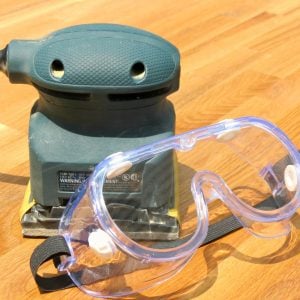[AdSense-A]Odds are you have used or thought about using an orbital sander at least once in your life. This type of sander is probably the most common and comes in two different forms for various types of comfort level and job. The standard orbital sander is square and is easily the most common and easiest to use while a random orbital sander is better for tackling bigger sanding jobs due to more power and its aggressive nature.
Orbital sanders are really easy to use, and as long as your practice good safety and understand all the ins and outs, you shouldn’t have any problem. The following tips will help you get the most out of using your orbital sander including saving time, money, and a whole lot of work.
Safety First
First and foremost, always practice safety when using any sort of power tools. Although most would say this is common knowledge, it’s amazing how many people injure themselves while not taking the simple measures to be safe. Accessories such as eye glasses with side shields, mask, and a vice are some of the simplest safety precautions which everyone seems to forget.
Determine Which Type of Orbital Sander You Need
Both types of orbital sanders will tackle most sanding jobs, but for bigger jobs such as sanding sheet rock it’s recommended to use a random orbital sander. The elliptical and random nature of the sanding action of the random variant along with more power and speed makes it fitting to make big changes, aggressively, and quick.
Many of the pros would say that traditional orbital sanders are better suited for beginners, but this statement is far from all-inclusive. Both are relatively easy to use and are perfect for one-handed operation. This gives you the ability to use your other hand to make adjustments while sanding, although, this isn’t typically recommended.
Determine Which Grit of Sand Paper You Need
Sandpaper comes in different grit which determines the coarseness. The grit ranges from 60 – 240 with the lower number better suited for sanding larger, heavier projects. It’s recommended to use a step up methodology in the grit starting out with a lower, coarser number while working your way up to a smaller, finer number.
Allow the Sander and Sand Paper to do the Work, Not Your Arms
Many people believe the sanding action is determined by how much brute force you can transfer to the sander, and let me tell you this is far from the truth. In essence, the sander and sand paper itself should be doing all the work while your arms and hands act as a guide for control.
The amount of power, speed, and the overall sanding action itself is determined by the electrical action of the sander, and not the mechanical action yourself. Choosing the proper sand paper grit will make any job much easier and will save you a great deal of energy in the process. Be sure to move the sander in the same plan as the paper when using an orbital sander, and when using a random orbital sander, you want to make sure the sanding disk is flush with what is being sanded.
Using Clamps is Always Better than Holding
An orbital sander is a one-handed sander, but this doesn’t necessarily mean you have to hold what’s being sanded in place manually. Using clamps is a much better option as it frees your other hand which will give you even more control and helps reduce any movement. There is nothing more annoying than sanding a piece of wood that won’t stay still not to mention it increases the chances of unwanted scratches.
If using a clamp, be sure to place a towel or other soft material between the clamp and the material being sanded. The clamp itself can damage the material, especially if it’s too tight. If you’re one of the many who have used a clamp and realized when you thought you were done with your project only to have to do it again to remove those unwanted marks, then this is one step you will never forget.
Take Necessary Steps to Minimize Dust Before Sanding
As is the case with many DIY projects, taking the extra time beforehand will help minimize the amount of work and time you actually have to put in. Creating a barrier such as laying sheets or plastic under the immediate area will help minimize sanding dust which will inevitably have to be cleaned up.
Sanding in a well ventilated area or even outdoors is even best. Breathing in the dust and particles isn’t exactly something you’ll want to do as there are many things that can be considered in order to minimize this. A vacuum bag attachment is available for many orbital sanders which will collect the particles, and it’s always good practice to wear a sanding mask.
Find Out More on the Top Safety Tips for Sanding From the Pros
[AdSense-A]






It’s very crucial and helpful info for woodworker. I’m very happy to read your article. Happy woodworking!